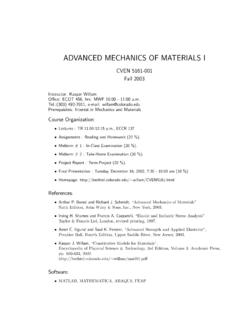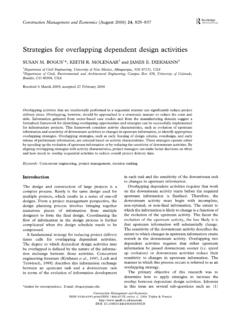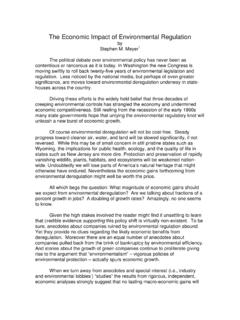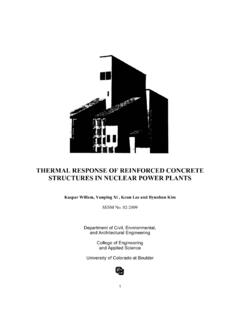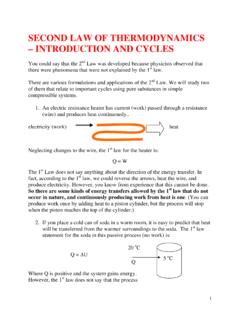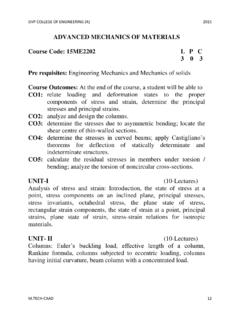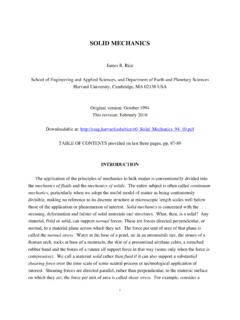Transcription of CVEN 5161 Advanced Mechanics of Materials I
1 CVEN 5161. Advanced Mechanics of Materials I. Instructor: Kaspar J. Willam Revised Version of Class Notes Fall 2003. Chapter 1. Preliminaries The mathematical tools behind stress and strain are housed in Linear Algebra and Vec- tor and Tensor Analysis in particular. For this reason let us revisit established concepts which hopefully provide additional insight into matrix analysis beyond the mere Mechanics of elementary matrix manipulation. Vector and Tensor Analysis (a) Cartesian Description of Vectors: Forces, displacements, velocities and accelerations are objects F , u, v, a <3 which may be represented in terms of a set of base vectors and their components. In the following we resort to cartesian coordinates in which the base vectors ei form an or- thonormal set which satisfies . 1 0 0. ei ej = ij i, j = 1, 2, 3 where [ ij ] = 1 = 0 1 0 ( ).
2 0 0 1. where the Kronecker symbol [ ij ] = 1 designates the unit tensor. Consequently, the force vector may be expanded in terms of its components and base vectors, 3. X. F = F1 e1 + F2 e2 + F3 e3 = Fi ei Fi ei ( ). i The last expression is a short hand index notation in which repeated indices infer summation over 1,2,3. In matrix notation, the inner product may be written in the form, . e1 F1. t . F = [F1 , F2 , F3 ] e2 [Fi ] = F2 .. ( ).. e3 F3. 1. where we normally omit the cartesian base vectors and simply represent a vector in terms of its components (coordinates). (b) Scalar Product (Dot Product) of Two Vectors: (F u) <3. The dot operation generates the scalar: W = (F u) = (Fi ei ) (uj ej ) = Fi uj ij = Fi ui ( ). Using matrix notation, the inner product reads F t u = Fi ui , where F t stands for a row vector and u for a column vector.
3 The mechanical interpretation of the scalar product is a work or energy measure with the unit [1 J = 1Nm]. The magnitude of the dot product is evaluated according to, W = |F ||u| cos ( ). 1 1. where the absolute values |F | = (F F ) and |u| = (u u) are the Euclidean lengths 2 2. of the two vectors. The angle between two vectors is defined as (F u). cos = ( ). |F ||u|. The two vectors are orthogonal when = 2 , (F u) = 0 if F 6= 0 and u 6= 0 ( ). In other terms there is no work done when the force vector is orthogonal to the dis- placement vector. Note: Actually, the mechanical work is the line integralR of the scalar product between the force vector times the displacement rate, W = F du. Hence the previous expressions were based on the assumption that the change of work along the integration path is constant. (c) Vector Product (Cross Product) of Two Vectors: (x y) <3 : The cross product generates the vector z which is orthogonal to the plane spanned by the two vectors x, y according to the right hand rule: z = x y = xi yj (ei ej ) where |z| = |x||y| sin ( ).
4 In 3-d the determinant scheme is normally used for the numerical evaluation of the cross product. Its components may be written in index notation with respect to cartesian coordinates zp = pqr xq yr ( ). 2. The permutation symbol pqr = 0, 1, 1 is zero when any two indices are equal, it is one when p, q, r are even permutations of 1, 2, 3, and it is minus one when they are odd. The geometric interpretation of the cross product is the area spanned by the two vectors, |z| = A. In other terms the determinant is a measure of the area subtended by the two vectors x y, where . e1 e2 e3. 1 x2 x3 . z = det x ( ).. y1 y2 y3. The scalar triple product V = z (x y) measures the volume spanned by the three vectors: . x1 x2 x3. V = |z|cos |x||y|sin = det y1 y2 y3 .. ( ). z1 z2 z3. (d) Tensor Product (Dyadic Product) of Two Vectors: u v <3 : The tensor product of two vectors generates a second order tensor ( a matrix of rank-one) A(1) : A(1) = u v = ui ei vj ej = ui vj ei ej = [ui vj ] ( ).
5 In matrix notation the tensor product writes as u v = [ui vj ] = uv t . Expanding, we have . u1 v1 u1 v2 u1 v3. u v = [ui vj ] = u2 v1 u2 v2 u2 v3 .. ( ). u3 v1 u3 v2 u3 v3. The linear combination of three dyads is called a dyadic' which may be used to generate a second order tensor of full rank three, A(3) : 3. (3). X. A = ak u k v k ( ). k=1. Spectral representation of a second order tensor A(3) expresses the tensor in terms of eigenvalues i and eigenvectors. They form an orthogonal frame which may be normalized by ei ej = 1 such that, 3. A(3) =. X. i ei ei ( ). i=1. 3. Note: the tensor product increases the order of of the resulting tensor by a factor two. Hence the tensor product of two vectors (two tensors of order one) generates a second order tensor, and the tensor product of two second order tensors generates a fourth order tensor, etc.
6 (e) Coordinate Transformations: Transformation of the components of a vector from a proper orthonormal coordinate system e1 , e2 , e3 into another proper orthonormal system E 1 , E 2 , E 3 involves the op- erator Q of direction cosines. In 3-d we have, Q = cos(E i ej ) ( ). where the matrix of direction cosines is comprised of, e1 e2 e3. E1 cos(E1 e1 ) cos(E1 e2 ) cos(E1 e3 ). ( ). E2 cos(E2 e1 ) cos(E2 e2 ) cos(E2 e3 ). E3 cos(E3 e1 ) cos(E3 e2 ) cos(E3 e3 ). The Q-operator forms a proper orthonormal transformation, Q 1 = Qt it satisfies the conditions, Qt Q = 1 and det Q = 1 ( ). In the case of 2-d, this transformation results in a plane rotation around the x3 -axis, . cos sin 0. Q = sin cos 0 .. ( ). 0 0 1. where 0 for counterclockwise rotations according the right hand rule. Conse- quently, the transformation of the components of the vector F from one coordinate system into another, =Q F.
7 F . and inversely F = Qt F ( ). The (3 3) dyadic forms an array A of nine scalars which follows the transformation rule of second order tensors, = Q A Qt A Q. and inversely A = Qt A ( ). This distinguishes the array A to form a second order tensor. 4. (f ) The Stress Tensor: Considering the second order stress tensor as an example when A = then the linear transformation results in the Cauchy theorem, that mapping of the stress tensor onto the plane with the normal n results in the traction vector t: t n = t or ji nj = ti ( ). This transformation may be viewed as a projection of the stress tensor onto the plane with the normal vector nt = [n1 , n2 , n3 ], where . 11 12 13. = 21 22 23 .. ( ). 31 32 33. with the understanding that = t is symmetric in the case of Boltzmann continua. The Cauchy theorem states that the state of stress is defined uniquely in terms of the traction vectors on three orthogonal planes t1 , t2 , t3 which form the nine entries in the stress tensor.
8 Given the stress tensor, the traction vector is uniquely defined on any arbitrary plane with the normal n, the components of which are, . 11 n1 + 21 n2 + 31 n3. t t = n = 12 n1 + 22 n2 + 32 n3 ( ).. 13 n1 + 23 n2 + 33 n3. The traction vector t may be decomposed into normal and tangential components on the plane n, n = n t = n t n ( ). and ( n )2 = |t|2 n2 = t t (n t)2 ( ). which are the normal stress and the tangential stress components on that plane. (g) Eigenvalues and Eigenvectors: There exist a nonzero vector np such that the linear transformation t np is a multiple of np . In this case nkt we talk about principal direction n = np in which the tangential shear components vanish, t np = np ( ). The eigenvalue problem is equivalent to stating that [ t 1] np = 0 ( ). 5. For a non-trivial solution np 6= 0 the matrix ( t 1) must be singular.
9 Consequently, det( t 1) = 0 generates the characteristic polynomial p( ) = det( t 1) = 3 I1 2 I2 I3 = 0 ( ). where the three principal invariants are, I1 = tr = ii = 1 + 2 + 3 ( ). 1 1. I2 = [tr 2 (tr )2 ] = [ ij ij ii2 ] = [ 1 2 + 2 3 + 3 1 ] ( ). 2 2. I3 = det = 1 2 3 ( ). According to the fundamental theorem of algebra, a polynomial of degree 3 has exactly 3 roots, thus each matrix <3 has 3 eigenvalues 1 = 1 , 2 = 2 , 3 = 3 . If a polynomial with real coefficients has some non-real complex zeroes, they must occur in conjugate pairs. Note: all three eigenvalues are real when the stress tensor = t is symmetric. Further, det( t 1) = ( 1)3 det( 1 t ), thus the roots of both characteristic equations are the same. (i) Similarity Equivalence: Similarity transformations, triple products of the form = S 1 S. ( ). , then the characteristic preserve the spectral properties of.
10 In other terms, if . polynomial of is the same as that of . 1) = det(S 1 S S 1 S) = det( 1). p( ) = det( ( ). (j) Orthonormal or Unitary Equivalence: A matrix U <3 is unitary (real orthogonal) if U t U = 1 and U t = U 1 ( ). with det U = 1 for proper orthonormal transformations. Consequently each unitary , where transformation is also a similarity transformation, . = U 1 U = U t U. ( ). but not vice versa. Note: Unitary equivalence distinguishes second order tensors from matrices of order three, since it preserves the length of the tensor in any coordinate system. In other terms, a zero length tensor in one coordinate system will have zero length in any other coordinate system. 6. (k) Cayley-Hamilton Theorem: This theorem states that every square matrix satisfies its own characteristic equation. In other terms the scalar polynomial p( ) = det( 1 t ) also holds for the matrix polynomial p( ).
